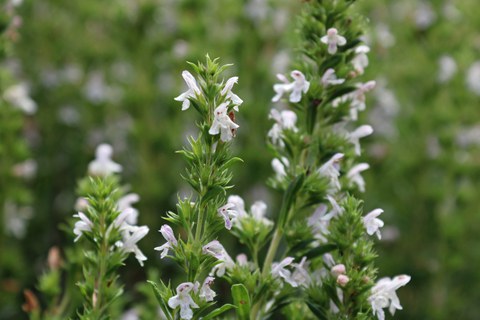Previous plants of the week - The winter savory
Satureja montana L.

Die Lippenblüten von Satureja montana L. erscheinen ab etwa August an den vierkantigen Stängeln mit den lineal-lanzettlichen Blättern.
It is a child of the sun: the natural distribution area of the perennial winter savory covers the whole of southern Europe and extends from there to Syria. In its native habitat, it often colonizes poor, well-drained limestone soils. In the 9th century, Benedictine monks brought the plant over the Alps from the Mediterranean region. Unlike summer savory, the twigs can be harvested all year round.
Essential oils give the herb an aromatic scent. The leaves are used dried or fresh for seasoning. Like many other of the approximately 60 species of the genus Satureja, winter savory is also used in folk medicine, for example to treat gastrointestinal cramps, nausea and diarrhoea. Ongoing research confirms, among other things, an antibacterial effect of the essential oils.
The semi-shrub from the labiate family, which grows up to 40 cm tall, forms delicate (up to 1 cm in size), light purple, rarely also pink or whitish colored flowers. Their nectar attracts many bees, hoverflies and butterflies. The petals, which grow together to form a lower lip, serve as a landing site for the hungry pollinators.
Winter savory grows in three places in the Botanical Garden. The plants in the Oriental area and in the perennial system are genetic twins: the plants in the perennial system originate from rooted cuttings of the specimen in the Oriental area. It is not known when and how this came to the Botanical Garden. This old plant was already present when the plant population was first recorded according to today's standards (1975). The winter savory in the kitchen garden came to the Botanical Garden as seed from Liguria (Italy) in 1990.
This year, the plants come into flower at different times, as observant visitors can see: The winter savory in the perennial system flowers much earlier than the other two. This is thanks to the sunnier location in the garden.
(KW 30)
